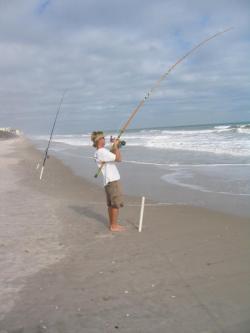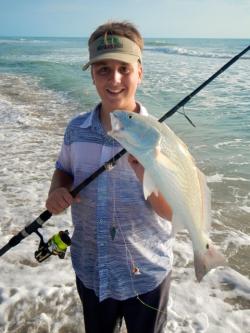Locating Fish in the Surf
by Captain Rodney Smith
from The Fishing Wire
Taking the time to learn the intricacies of surf fishing can help to expand and improve on one’s overall knowledge of fishing because of its many facets.
At the right time of year, snook can be a prime target for surf anglers along Florida’s east coast, particularly from Cape Canaveral southward. (Rodney Smith Photo)The first tip for anglers searching new waters for fishy places is to go buy a chart, study it and highlight the suspicious areas, particularity points, pockets and passes. But when it comes to surf fishing from the beach, especially the areas I fish most often along Florida’s central east coast, this may not be your best starting point. The beach is such a dynamic and changeable place that charts will not give you the foundation needed to get a grasp on where to get started and what to look for while surf fishing.
The exception to this is charts that are geared strictly for sharing surf fishing information. In my first book, Catching Made Easy, I included several chapters that should help you locate more fish. In these chapters I focus on how to develop a successful game plan, touch on the importance of listening to your intuition, and dive into where you can find the hotspots. I’ve published a couple of Catching Made Easy Surf Fishing Maps for a portion of the Indian River Coast, which should help you locate the places where fish might be hanging out.
Scout the beaches; take a walk with or without your fishing rod and reel, but don’t forget your binoculars. A good pair is a helpful tool when surveying new waters or when searching for diving birds and bait pods. Ask other anglers questions. Go to the local bait and tackle shop, get to know the folks working and hanging out there at the shop. Ask questions, and be grateful when anglers share their knowledge and experience with you.
It’s been my experience that this one tactic will help you locate the most desirable places to start. In most cases ninety percent of the fish are found in ten percent of the water. In the surf you need to establish the location of sandbars, the trough between the shore and sandbar, and the swash and run-outs, aka rip currents.
A long surf rod and a good eye for the right spots are keys to success in surf fishing. (Rodney Smith Photo)It’s important to remember fishy surf spots can and will vary for a number of reasons, including changes in water temperature, time of day, seasons, bait availability, rainfall, wind direction, tides, etc. And don’t forget that in the surf one storm or big ground swell can completely transform the playing field.
Quite often, fishy spots will stand out like a crooked nose. Other times, it might be a very subtle hint that gives these places away. For instance; when surf fishing a flat, long stretch of beach the run-outs and feeding areas are probably not going to be obvious to the inexperienced eye, but over time and much observation things like recognizing a steady flow of water traveling out a certain cut through a sandbar or break in a reef will become more easily spotted.
Keep an eye out for bait. Seeing ghost crabs on the beach, sand fleas (mole crab) down in the swash, and finger mullet or glass minnows (a number of different species of baitfish are called glass minnows, including Spanish and bay anchovies) holding near shore is a good sign. Feeding birds is another good indicator that game fish are close. Remember, gulls are scavengers and terns and pelicans prefer live baits.
While finding fish is a very important part of catching, it’s only a portion of successful fishing. Other factors, like reading the water, understanding fish habits, making your cast count and being prepared can often be equally important to catching more fish.
Take it from me, the task of finding fish hasn’t changed much during the 50- plus years I’ve been hunting for them. If you locate healthy habitat, those places that provide food, shelter or both, you will find fish. Word of mouth can be very important; the information you can get from someone more experienced or an angler with local knowledge will go a long ways down the road toward success.
Talk to anglers fishing the waters where you’re scouting. Instead of asking them if they’re catching fish, ask them if they are fishing or catching. This usually loosens them up and they’re more willing to share their fishing stories. Remember to make friends with the guy or gal at your local bait and tackle shop, too. They work hard providing services you need, and they are also purveyors of very useful and up-to-date information. Surf fishing venues are some of the fastest changing places in the world to fish, so it is particularity nice to get to know someone who keeps their finger on the pulse.
Redfish are another favorite species for Florida surf anglers, and they come in all sizes from “keepers” like this one to giants of 30 pounds and more. (Rodney Smith Photo)Sidebar: When exploring the surf by foot looking for game fish crashing bait pods, try to keep it simple. For example, bring along a seven-to-nine foot, medium-weight spinning rod with you (depending on the size of the lures you will be casting and fish you are targeting). Wearing a vest with multiple pockets to stowaway poppers, diving lures (crank baits) and D.O.A. plastic baits plus leaders, dehooker and binoculars is best. I’ll usually bring along an assortment of smaller white or pink bucktails and a handful of silver or gold spoons. These work well when encountering Spanish mackerel, bluefish, snook, pompano and other fishes cruising the surf.
This changes when it comes to fishing baits in the surf, like live sand fleas, cut clams or shrimp in the cooler months for pompano, whiting and drum. In this case, a twelve-foot rod is most manageable and works best at keeping the line above the pull of the surf when using a bottom rig and heavier weight. Your binoculars can still come in handy when you want to see what the other surf anglers are catching down the beach.
Once you get serious about improving your ability to locating productive surf fishing spots you will also develop your own personal tactics and techniques leading you down the road to success.
Learn more about Florida’s fishing and natural resources by reading or listening to Captain Rodney Smith’s books Catching Made Easy and Enjoying Life on the Indian River Lagoon Coast. To contact Capt. Smith about a private fishing lesson, call him at 321-750-3374, or send an email to irlcoast@gmail.com. And don’t forget to check out www.rodneysmithmedia.com.


